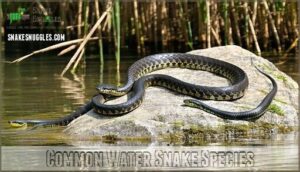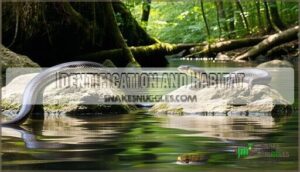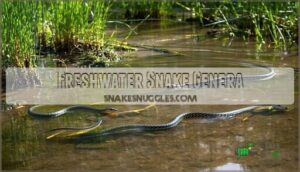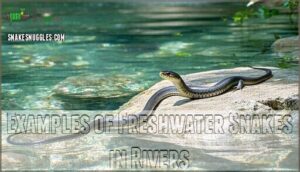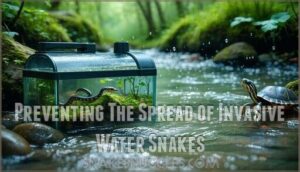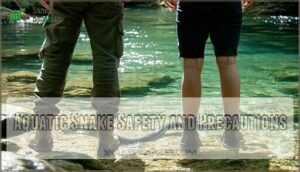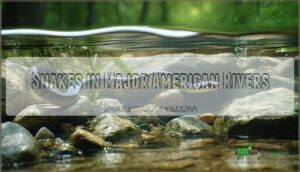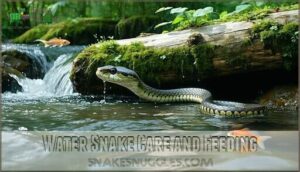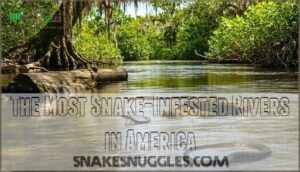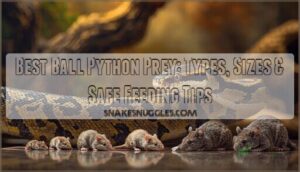This site is supported by our readers. We may earn a commission, at no cost to you, if you purchase through links.
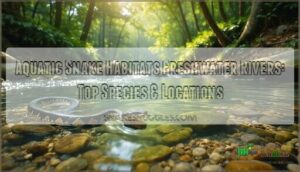
Common water snakes, cottonmouths, and garter snakes thrive in rivers, streams, and lakes across North America.
These reptiles prefer slow-moving waters with plenty of vegetation and rocky hideouts for hunting fish, frogs, and small mammals.
They’re excellent swimmers who can hold their breath for impressive stretches while stalking prey underwater.
Water temperature matters too – most species need temps between 70-85°F to stay active.
From the Mississippi’s muddy banks to crystal-clear mountain streams, different snake species have adapted to specific river conditions.
Some surprising secrets about which rivers harbor the most snakes might change where you plan your next swim, considering the diverse species and their preferences for certain river conditions.
Table Of Contents
- Key Takeaways
- Types of Snakes in Freshwater Rivers
- Water Snake Habitat Preferences
- Snakes Found in North American Freshwater
- What Snakes Live in Freshwater Biomes?
- Preventing The Spread of Invasive Water Snakes
- Aquatic Snake Safety and Precautions
- Snakes in Major American Rivers
- Water Snake Care and Feeding
- The Most Snake-Infested Rivers in America
- Can Sea Snakes Survive in Freshwater?
- Frequently Asked Questions (FAQs)
- Do water snakes live in rivers?
- Are there any fully aquatic freshwater snakes?
- What is the preferred habitat of a water snake?
- Where do sea snakes get freshwater?
- What snakes live in the freshwater biome?
- Can sea snakes survive in freshwater?
- What to do if you see a snake while swimming in a lake?
- What is the average lifespan of a water snake?
- Can water snakes be kept as pets in aquariums?
- How do water snakes adapt to changing water temperatures?
- Conclusion
Key Takeaways
- You’ll find water snakes thriving in slow-moving freshwater rivers with dense vegetation, rocky hideouts, and temperatures between 70-85°F – these conditions provide ideal hunting grounds for fish, frogs, and small mammals.
- Most river snakes you’ll encounter are completely harmless despite looking intimidating – species like Northern Water Snakes and Diamondback Water Snakes are non-venomous swimmers that play vital roles in controlling prey populations.
- You can stay safe while enjoying snake-inhabited waters by wearing protective gear, avoiding murky areas with dense vegetation, swimming with others, and learning to identify local species before entering the water.
- You should never release pet snakes into wild waterways as this creates devastating ecological impacts – invasive species like Northern Water Snakes can outcompete native wildlife and disrupt entire freshwater ecosystems.
Types of Snakes in Freshwater Rivers
When you’re exploring freshwater rivers, you’ll encounter several fascinating snake species that have adapted perfectly to aquatic life.
Most of these water-dwelling snakes belong to the Nerodia genus and are completely harmless, though they’re often mistaken for dangerous species like cottonmouths.
Common Water Snake Species
America’s river systems teem with fascinating water snake species that you’ll encounter during your freshwater adventures.
These non-venomous serpents play vital roles in river snake ecology, though identification challenges often lead to unnecessary fear.
Here are five common freshwater snake species you’re likely to spot:
- Northern Watersnake (Nerodia sipedon) – Heavy-bodied with dark crossbands that fade with age
- Banded Watersnake (Nerodia fasciata) – Distinguished by distinctive square belly blotches and dark banding
- Copperbelly Watersnake (Nerodia erythrogaster) – Features a striking copper-colored belly and plain back
- Diamondback Watersnake (Nerodia rhombifer) – Large species with diamond-shaped light markings
- Green Water Snake (Nerodia cyclopion) – Slender build with greenish coloration
These examples of freshwater snakes in rivers showcase the diversity within the Nerodia genus.
The related red bellied water snake is another non-venomous species often found in aquatic habitats.
All possess keeled scales for their aquatic lifestyle and excel at swimming with heads above water.
Understanding these common water snake species helps you appreciate their ecological importance while recognizing that they’re harmless despite their intimidating appearance.
Identification and Habitat
When you’re exploring freshwater rivers, identifying water snake species requires careful observation of their distinctive features.
Look for species markings like crossbands, blotches, or solid coloration patterns.
Scale patterns reveal keeled textures that feel rough to touch.
Habitat overlap occurs frequently—multiple freshwater snake species share similar basking spots along riverbanks.
River ecology supports diverse aquatic snake habitats where snake habitat types include slow-moving waters with vegetation.
Aquatic snake identification becomes easier when you understand these key characteristics.
Freshwater Snake Genera
The diversity of freshwater snake genera reveals nature’s remarkable adaptability.
You’ll find Nerodia leading the pack in North America, but several other genera thrive in aquatic environments.
The Colubridae family dominates freshwater habitats with specialized adaptations.
Key freshwater snake genera include:
- Nerodia – Masters of rivers and lakes with keeled scales
- Thamnophis – Garter snakes perfectly suited for wetland edges
- Regina – Crayfish specialists thriving in muddy bottoms
- Agkistrodon – Venomous water moccasins dominating southern waters
Examples of Freshwater Snakes in Rivers
Rivers teem with fascinating water snakes that have mastered aquatic life.
You’ll spot the Northern Water Snake with its dark crossbands and the Diamondback Water Snake displaying distinctive diamond patterns.
These species showcase remarkable adaptations for river living.
| Species | Length | Key Feature |
|---|---|---|
| Northern Watersnake | 2-4.5 feet | Dark crossbands, keeled scales |
| Banded Watersnake | Up to 5 feet | Square belly blotches, thick body |
| Diamondback Watersnake | 2.5-5 feet | Diamond-shaped light markings |
| Copperbelly Water Snake | 24-40 inches | Plain colored belly, solid back |
Each snake species has evolved unique snake diets and behaviors.
Northern Water Snakes prefer fish and amphibians, while Diamondback behavior includes aggressive defensive displays when threatened.
Water Snake Habitat Preferences
You’ll find that water snakes have specific habitat needs that make certain freshwater environments perfect for their survival.
Understanding these preferences helps you identify where different species thrive and what conditions they require to stay healthy in both wild and captive settings, which is crucial for their overall survival.
Ideal Freshwater Habitats for Snakes
Water snakes prefer freshwater rivers with specific habitat features that support their aquatic lifestyle.
You’ll find them in areas where river flow moves slowly, allowing for easier hunting and navigation.
Key habitat features include:
- Vegetation density – Dense aquatic plants and overhanging branches provide cover and hunting opportunities
- Water clarity – Clear to moderately turbid water supports diverse prey populations
- Basking sites – Rocks, logs, and riverbank areas offer essential thermoregulation spots
- River flow – Slow to moderate currents create ideal hunting and shelter conditions
- Prey abundance – Rich fish and amphibian populations sustain healthy snake communities
These ideal freshwater habitats for snakes combine protection, food sources, and suitable water conditions that make aquatic snake habitats thrive in lush vegetation environments.
Temperature and Humidity Requirements
Throughout aquatic snake habitats in freshwater rivers, maintaining proper temperature and humidity requirements creates the foundation for healthy snake populations.
You’ll need Optimal Ranges of 70-90°F (21-32°C) with Basking Spots around 95°F (35°C) for thermoregulation.
Captive Enclosures require these specific conditions:
- Use thermostats to regulate temperature and prevent dangerous fluctuations
- Increase Shedding Humidity to 60-70% during molting periods
- Monitor Seasonal Variation as natural temperature cycles affect snake behavior
Humidity levels between 30-60% support respiratory health and proper skin shedding.
Water quality directly impacts these requirements, as poor conditions stress snakes and disrupt their natural temperature regulation processes.
Substrate and Decorations for Water Snakes
Your water snake’s home needs the right foundation and features. Safe substrates like aspen shavings or reptile carpet work best—skip pine and cedar as they’re toxic.
Create naturalistic design with aquatic plants, driftwood, and rocks for shelter. Here’s what works:
| Substrate Type | Suitability |
|---|---|
| Aspen shavings | Excellent – natural, safe |
| Reptile carpet | Good – easy cleaning |
| Paper towels | Temporary – sterile option |
| Pine/Cedar | Never – toxic oils |
| Cypress mulch | Good – holds humidity |
Enrichment items mimic lush vegetation found in freshwater rivers. Your snake needs hiding spots and climbing branches. Decoration size should allow easy movement—nothing too small that could cause impaction.
Cleaning frequency depends on your substrate choice, but spot-clean waste immediately for healthy aquatic snake habitats. Many owners find that safe reptile carpets offer a practical solution for enclosure flooring.
Space and Tank Requirements for Water Snakes
Several factors determine the ideal tank size for your water snake’s health and happiness.
You’ll need at least a 40-gallon breeder tank with secure mesh lid for proper ventilation. A larger tank option is often preferred.
Include a basking area with appropriate temperature and lighting. Water volume should allow full swimming while maintaining water quality through filtration.
Consider enrichment needs like hiding spots and climbing branches for natural behavior.
Snakes Found in North American Freshwater
North America’s freshwater rivers host an impressive variety of snake species, from the common Northern Water Snake to the distinctive Diamondback Water Snake.
You’ll find these aquatic reptiles thriving in river systems across the continent, each adapted to specific freshwater environments and playing vital roles in their ecosystems.
Snakes in The Mississippi River Basin
You’ll find at least 12 Mississippi Snakes thriving in the basin’s diverse aquatic snake habitats.
The Northern Watersnake dominates freshwater rivers, hunting fish along muddy banks.
Timber Rattlesnakes, the region’s largest venomous species, control rodent populations from Minnesota to the Gulf.
Unfortunately, the Mississippi Green Watersnake faces extinction due to habitat loss, highlighting urgent conservation needs throughout the Mississippi River Basin.
These snakes thrive in snake-infested habitats like marshes and swamps.
Snakes in The Missouri River Basin
The Missouri River Basin hosts 47 snake species, including northern watersnakes (Nerodia sipedon) and diamond-backed watersnakes.
You’ll find these Missouri snakes thriving in the river’s diverse aquatic snake habitats, from backwaters to oxbow lakes.
However, conservation challenges threaten species distribution as habitat loss impacts human-snake interactions throughout this expansive freshwater rivers ecosystem.
The Missouri River is considered the most snake-infested river in the nation, with habitat loss and human-snake interactions being key concerns.
Snakes in The Rio Grande River Basin
You’ll discover over 30 Rio Grande species thriving in this massive freshwater river system, though only two are venomous.
The blotched water snake lives exclusively between Hot Springs and Boquillas Canyon, while checkered garter snakes patrol floodplains.
These aquatic snake habitats support diverse populations despite habitat conservation challenges and invasive impact concerns affecting water quality.
Snakes in The Alabama River Basin
The Alabama River Basin hosts at least 10 aquatic snake species, making it one of the most snake-dense waterways in the southeastern United States.
You’ll encounter both venomous and non-venomous species throughout this diverse ecosystem.
Here are the top Alabama snakes you might spot:
- Northern Cottonmouth – The basin’s only venomous aquatic snake, recognizable by its thick body and white mouth lining
- Brown Water Snake – Can reach 55 inches long and often gets mistaken for the dangerous cottonmouth
- Plain-bellied Water Snake – The most widespread species you’ll find, with two subspecies calling Alabama home
What Snakes Live in Freshwater Biomes?
You’ll find several types of snakes thriving in freshwater biomes, each with specialized diets that help them survive in aquatic environments.
These snakes have adapted to hunt different prey, from fish and amphibians to rodents and insects that live near or in the water, which is crucial for their survival in aquatic environments.
Fish-Eating Snakes in Freshwater Biomes
In freshwater rivers, you’ll spot fish-eating snakes with remarkable dietary adaptations for aquatic life.
Northern Water Snakes and Diamondback Water Snakes showcase specialized hunting strategies, using ambush tactics to catch fish in river ecosystems.
Their prey selection focuses on fish and amphibians, while efficient digestion efficiency supports their aquatic snake diet in diverse freshwater ecosystems.
Some species require safe fish options to avoid health risks.
Amphibian-Eating Snakes in Freshwater Biomes
The dynamics of amphibian predation shape freshwater ecosystems in fascinating ways.
You’ll find these specialized hunters targeting frogs, toads, and salamanders throughout North American rivers and streams.
- Frog Predation: Northern water snakes excel at catching bullfrogs and green frogs near riverbanks
- Salamander Diet: Aquatic snakes hunt mudpuppies and newts in shallow, vegetated areas
- Tadpole Consumption: Young amphibians provide easy prey for smaller freshwater snake species
- Caecilian Eaters: Some river snake predators target these worm-like amphibians in muddy substrates
These amphibian-eating snakes maintain vital balance in freshwater ecosystems through their specialized hunting behaviors.
Rodent-Eating Snakes in Freshwater Biomes
While most freshwater snakes prefer fish and amphibians, some species like the Northern Water Snake occasionally hunt rodents near riverbanks.
These rodent-eating snakes help maintain biome balance by controlling populations of mice and rats that venture close to water.
Their snake predation patterns adapt to available prey, making them valuable allies in freshwater rivers where invasive rodents threaten native ecosystems through natural control methods.
Insect-Eating Snakes in Freshwater Biomes
While some water snakes focus on fish and amphibians, others target insect-eating snakes in freshwater rivers.
These insectivore species use specialized feeding strategies to hunt aquatic insects, mosquito larvae, and small invertebrates.
Their dietary adaptations create significant biome impact by controlling pest populations.
Water snakes with varied diets help maintain balanced aquatic snake habitats through natural pest control, though their conservation status varies by region.
Preventing The Spread of Invasive Water Snakes
You can prevent the spread of invasive water snakes by never releasing pet snakes into local waterways, where they can outcompete native species and disrupt entire ecosystems.
Responsible snake ownership means keeping your pet for life or finding proper rehoming through reptile rescues rather than dumping them in rivers or lakes, which is a key part of responsible snake ownership and helps prevent the spread of invasive species.
The Northern Watersnake Invasion
Since 2007, Northern Watersnakes have invaded California’s freshwater rivers, creating serious ecological problems.
These non-native snakes now threaten your local aquatic ecosystems through aggressive range expansion and prey depletion.
Here’s how the Northern Watersnake invasion impacts freshwater rivers:
- Ecological impact – They consume native fish and amphibians at alarming rates
- Native competition – They directly compete with threatened giant garter snakes
- Prey depletion – Some wetlands now lack native species entirely
- Control methods – Professional trapping targets younger snakes most effectively
Risks of Releasing Non-Native Snakes
Releasing non-native snakes creates devastating Ecological Impacts and Disease Introduction risks in freshwater rivers.
These invaders outcompete native species, cause Genetic Pollution through interbreeding, and create severe Predation Effects on local wildlife.
The Economic Costs from habitat restoration and snake population decline burden taxpayers.
Don’t contribute to habitat loss and snake habitat threats plaguing our waterways.
Responsible Pet Ownership and Snake Release
Ethical Considerations demand lifelong commitment when you adopt a snake.
Don’t release pet snakes into wild habitats—Release Consequences include creating Invasive Species that threaten native ecosystems.
Instead, choose Responsible Alternatives like rehoming through reptile rescues or veterinary surrender programs.
Understanding Legal Ramifications protects both snake habitat preservation and snake conservation efforts while promoting snake education and snake awareness.
Regulations on Non-Native Snake Possession
Before owning exotic snake species, you’ll need to navigate a complex web of regulations.
Federal snake laws, state snake laws, and local ordinances create layers of permit requirements that vary substantially by location and species.
Here’s what you must verify:
- Federal permits – Required for endangered snake species or interstate transport
- State licensing – Many states ban specific snake species outright or require special permits
- Local restrictions – Cities and counties often impose additional snake conservation rules
Enforcement challenges mean violations can result in hefty fines and confiscation of your pets.
Aquatic Snake Safety and Precautions
When you’re exploring freshwater rivers where snakes live, you’ll want to know how to stay safe and what to do if you encounter these aquatic reptiles.
Taking the right precautions can help you enjoy water activities while avoiding potentially dangerous situations with both venomous and non-venomous snake species, and staying safe is a key part of enjoying freshwater rivers.
Safety Measures for Swimming in Snake-Infested Areas
Swimming in snake-infested areas requires smart snake precautions. Wear protective gear like water shoes and avoid murky waters where snake encounters are common.
Stay alert for movement and swim with others for safety. Don’t reach into dark spaces or tall vegetation.
Safe swimming practices include checking local warnings about snake activity and learning identifying local snakes before entering water.
First Aid for Snake Bites in Freshwater
Being bitten by a snake while swimming can feel terrifying, but quick action saves lives.
Exit the water immediately and stay calm to prevent venom from spreading faster.
Follow these critical steps:
- Identify Snake species if safely possible for proper antivenom access
- Call 911 immediately while applying clean bandages for wound care
- Keep bite below heart level and remove jewelry before swelling begins
Watch for bite symptoms like swelling, nausea, or difficulty breathing.
Never apply ice or tourniquets.
Seek medical attention within 30 minutes for best outcomes with snake venom treatment.
Snake-Repellent Plants and Deterrents
Beyond basic first aid, you’ll want to prevent snake encounters altogether.
Snake-repellent plants offer natural barriers around freshwater areas. Marigolds, lemongrass, and garlic create scent aversion that deters snakes.
However, plant effectiveness varies, and repellent longevity requires regular maintenance for reliable snake prevention.
Many gardeners purchase plants online to confirm they’ve the right varieties.
| Plant Type | Effectiveness | Maintenance | Best Location |
|---|---|---|---|
| Marigolds | Moderate | Monthly | Garden borders |
| Lemongrass | High | Weekly | Near water features |
| Garlic/Onions | Variable | Seasonal | Around camping areas |
| Lavender | Low-Moderate | Monthly | Pathways |
Snakes in Major American Rivers
You’ll find fascinating aquatic species when exploring America’s major river systems, from the Arkansas to the Colorado.
Each waterway hosts unique snake populations adapted to their specific freshwater environments and regional conditions.
Snakes in The Arkansas River
Exploring the Arkansas River reveals one of America’s most snake-rich waterways, where you’ll encounter both venomous and harmless species.
This diverse ecosystem supports various Arkansas species that thrive in freshwater rivers environments.
Five key snake species you’ll find:
- Yellow-bellied water snake – Non-venomous, reaches 48 inches, excellent swimmer
- Diamondback water snake – Harmless species found in fast-flowing sections
- Northern cottonmouth – Only venomous semi-aquatic species in the river
- Black rat snake – Controls rodent populations near riverbanks
- Speckled kingsnake – Eats other snakes, including venomous ones
These water snakes play vital roles in river ecology by controlling fish and amphibian populations.
Mississippi also faces challenges in snake habitat preservation, impacting species distribution.
Snake behavior varies seasonally, with peak activity from March to October.
Human impact through habitat modification affects snake habitats, making conservation status monitoring essential.
The Arkansas River’s diverse snake species demonstrate the importance of protecting freshwater rivers ecosystems.
Snakes in The Cumberland River
The Cumberland River’s diverse aquatic snake habitats support over a dozen Cumberland Species, including Northern Watersnakes and Gray Ratsnakes.
These freshwater rivers provide ideal conditions for river snake population growth, though Human Impact threatens vulnerable species like Copper-bellied Watersnakes.
River Ecology remains balanced as Snake Behavior adapts to seasonal temperature changes.
Conservation Status monitoring helps protect these essential snake habitats from pollution and habitat loss, ensuring the long-term preservation of Cumberland Species.
Snakes in The Colorado River
The Colorado River ranks as the second most snake-infested river in Colorado, hosting nine native snake species including Northern water snakes, garter snakes, and bullsnakes.
You’ll find these Colorado River snakes thriving in rocky shorelines and vegetated areas.
However, invasive snake threats like Southern banded water snakes near Yuma create conservation challenges, disrupting river ecosystem impact through competition with native species, posing a threat to the native snake species and the overall river ecosystem.
Snakes in The Brazos River
The Brazos River in Texas harbors thirteen snake species, with the endangered Brazos Water Snake being the star resident.
You’ll find this threatened species clinging to rocky riffles and shallow waters.
Habitat threats like damming and invasive saltcedar jeopardize these specialized water snakes.
Conservation efforts focus on protecting riffle habitats essential for snake identification and survival in freshwater rivers.
Water Snake Care and Feeding
If you’re thinking about keeping freshwater snakes as pets, you’ll need to understand their specific care requirements to keep them healthy and happy.
Proper feeding, habitat setup, and handling techniques are essential for successfully maintaining these aquatic reptiles in captivity, which includes understanding their habitat setup.
Feeding Freshwater Snakes in Captivity
Feeding freshwater snakes in captivity requires understanding their natural diet and specific nutritional needs. Prey size should match your snake’s girth, while feeding frequency depends on age and species.
Most water snakes thrive on these feeding practices:
- Frozen vs. live prey – Frozen rodents are safer and more convenient than live options
- Sourcing prey from reputable suppliers guarantees quality and reduces disease risk
- Fish-eating snakes need whole fish or fish-based diets supplemented with vitamins
- Amphibian-eating snakes require frogs, salamanders, or appropriate substitutes
- Rodent-eating snakes do well on mice or rats sized appropriately
Supplementation needs vary by species, but calcium and vitamin D3 support healthy growth in most captive water snakes.
Temperature, Lighting, and Humidity Requirements
Creating ideal temperatures for your water snake means establishing a thermal gradient that mimics their natural habitat.
Your snake needs distinct temperature zones for proper digestion and thermoregulation.
Understanding species-specific humidity needs is also essential for preventing health issues.
| Environmental Factor | Recommended Range |
|---|---|
| Warm End Temperature | 85°F (29°C) |
| Cool End Temperature | 70°F (21°C) |
| Basking Spot | 90°F (32°C) |
| Humidity Levels | 30-60% |
Lighting needs include UVA/UVB bulbs for 10-12 hours daily.
Seasonal variation isn’t critical in captivity, but maintaining consistent temperature and humidity requirements prevents stress and health issues.
Substrate and Decorations for Water Snake Tanks
With temperature and lighting dialed in, you’ll want Safe Substrates like cypress mulch or aspen shavings at 1-2 inches deep.
Add Enrichment Items such as driftwood and rocks for Hiding Spots.
Live Plant Choices like pothos thrive in humid conditions while providing shelter.
Cleaning Decor regularly prevents bacterial buildup.
These elements mimic lush vegetation found in freshwater rivers, supporting your snake’s aquatic snake adaptations naturally.
Handling and Safety Precautions for Water Snakes
Safe handling of water snakes requires preparation and respect for these aquatic creatures.
Most water snake bites happen when people try to catch or kill them unnecessarily.
- Learn snake behavior – Watch for defensive postures like coiling or flattening before approaching
- Maintain safe distance – Observe from at least 6 feet away for proper identification
- Use proper tools – Snake hooks or tongs prevent direct contact during necessary handling
- Know first aid basics – Clean wounds immediately and seek medical attention for severe bites
The Most Snake-Infested Rivers in America
America’s rivers host some of the continent’s most diverse snake populations, with certain waterways standing out as prime snake habitats.
You’ll find the highest concentrations of aquatic snakes in slow-moving rivers with abundant vegetation and ideal basking spots throughout the southeastern and midwestern United States.
Top 10 Rivers With High Snake Populations
When caring for water snakes becomes complex, you’ll want to know which freshwater rivers harbor the highest snake populations.
River Snake Diversity varies dramatically across America’s waterways, with Population Influences including prey availability and habitat quality determining Species Distribution patterns.
| River System | Notable Snake Species | Population Density |
|---|---|---|
| Mississippi River | Northern water snake, cottonmouth, timber rattlesnake | Highest in delta regions |
| Missouri River | Diamondback water snake, broad-banded water snake | 47 species across 2,500 miles |
| Arkansas River | Midland water snake, northern cottonmouth | 9 water snake species |
| Rio Grande | Western diamondback rattlesnake, Texas coral snake | Nearly 70 species statewide |
| Alabama River | Plain-bellied water snake, diamond-backed water snake | High biodiversity hotspot |
These snakes in major American rivers thrive where Conservation Priorities meet ideal Habitat Quality, making these waterways true reptilian highways.
Snakes Found in The American West and Southwest
Several Desert Water Snakes thrive in Western River Snakes habitats throughout Southwestern Habitats.
You’ll find them in the Rio Grande, Colorado River, and Brazos River systems.
These non-venomous species often get mistaken for Venomous Look-Alikes like cottonmouths.
Snake distribution patterns show they’re adapting well, though Conservation Challenges from habitat loss threaten their snake habitats across the arid Southwest, including issues related to habitat loss.
Snakes Found in The American Southeast and Midwest
Moving east from the western states, you’ll find the southeastern USA and Midwest regions home to numerous aquatic snake species.
The Mississippi River and Missouri River systems support diverse populations, with Northern Water Snake being particularly common. These waterways create perfect snake habitats with abundant prey and shelter.
Key southeastern and midwestern river snakes:
- Northern Water Snake – Most widespread species across both regions, excellent swimmers with keeled scales
- Banded Water Snake – Three subspecies including Florida watersnake, found in southeastern swamps and streams
- Copper-Bellied Water Snake – Distinctive orange-red belly, prefers slow-moving waters and wetlands
- Diamondback Water Snake – Large, aggressive species with diamond-shaped markings, common in southern rivers
Regional Snake ID becomes essential here due to Habitat Overlap between venomous and non-venomous species. Diet Variations include fish, amphibians, and small mammals. Conservation Status varies by species, with Human Encounters increasing near popular fishing spots. These snake habitats support healthy ecosystems throughout the region.
Can Sea Snakes Survive in Freshwater?
You might wonder if sea snakes can make the switch from saltwater to freshwater environments like rivers and lakes.
While most sea snakes are strictly marine creatures, a few species have adapted to tolerate or even thrive in brackish and freshwater habitats.
Sea Snake Adaptations for Freshwater Survival
Sea snakes can’t fully adapt to freshwater rivers despite some tolerance for brackish water.
Most sea snakes can’t survive in freshwater rivers due to their specialized salt-removal systems.
Osmoregulation challenges overwhelm their systems when salt gland function becomes ineffective in pure freshwater.
Dietary adaptation and reproductive success suffer under evolutionary pressures that favor saltwater survival.
While aquatic snake research shows limited freshwater tolerance, water snakes remain better suited for these snake habitats.
Examples of Sea Snakes Found in Freshwater
You’ll find several sea snake species that have adapted to freshwater environments, though they’re relatively rare.
The yellow-lipped sea krait and banded sea krait can handle lower salinity levels in river mouths and coastal freshwater systems.
These species show remarkable sea snake adaptation through modified osmoregulation systems that help them survive in both saltwater and freshwater habitats.
Here are notable examples of sea snakes in freshwater rivers:
- Yellow-lipped sea krait – Found in freshwater streams and rivers throughout Southeast Asia
- Banded sea krait – Enters freshwater lagoons and river systems to hunt for fish and eels
- Olive sea snake – Occasionally ventures into brackish and low-salinity freshwater areas
Limitations and Challenges for Sea Snakes in Freshwater
Marine reptiles face serious obstacles when venturing into freshwater rivers. Osmoregulation challenges top the list – sea snakes can’t handle the salt imbalance that freshwater creates in their bodies.
You’ll find their specialized kidneys work overtime, often failing to maintain proper fluid balance.
| Challenge | Impact | Outcome |
|---|---|---|
| Osmoregulation | Kidney failure | Death within days |
| Dietary restrictions | Limited prey | Starvation risk |
| Reproduction barriers | Failed breeding | Population decline |
Habitat suitability becomes another roadblock. These snakes need specific water temperatures and salinity levels that freshwater environments simply can’t provide.
Evolutionary constraints mean they’re hardwired for ocean life, making adaptation nearly impossible.
Frequently Asked Questions (FAQs)
Do water snakes live in rivers?
While many snakes avoid water like the plague, you’ll find water snakes thriving in rivers across North America.
These non-venomous swimmers call freshwater rivers home, preferring slow-flowing areas with dense vegetation and plenty of basking spots.
Are there any fully aquatic freshwater snakes?
While no freshwater snakes are truly 100% aquatic, you’ll find semi-aquatic species like Northern Water Snakes that spend most of their time in rivers, lakes, and streams.
But still come ashore to bask and reproduce.
What is the preferred habitat of a water snake?
Ever wonder where you’ll spot these slithery swimmers thriving?
Water snakes prefer slow-moving freshwater rivers, lakes, and ponds with dense vegetation, basking spots like logs, and temperatures between 70-90°F for hunting fish and amphibians.
Where do sea snakes get freshwater?
Sea snakes can’t drink seawater despite their salt glands.
Instead, they drink from freshwater "lenses" that form on the ocean surface during rainfall when salinity decreases enough to make water safe for consumption.
What snakes live in the freshwater biome?
Don’t judge a book by its cover when spotting freshwater snakes.
You’ll find Northern Water Snakes, Banded Water Snakes, and Diamondback Water Snakes thriving in rivers, lakes, and ponds across North America.
Can sea snakes survive in freshwater?
You can’t survive in freshwater long-term.
Sea snakes need freshwater to drink but they’re built for ocean life with salt glands and paddle-like tails that make them inefficient swimmers in rivers.
What to do if you see a snake while swimming in a lake?
Don’t panic! Stay calm and slowly back away from the snake without sudden movements. Most lake snakes aren’t venomous and prefer avoiding you too.
What is the average lifespan of a water snake?
Water snakes typically live 9-12 years in the wild, though you’ll find some reaching 15 years under ideal conditions.
Captive water snakes often live longer due to consistent care and veterinary support.
Can water snakes be kept as pets in aquariums?
You can keep certain water snake species as pets, but they require large aquariums with proper filtration, heating, and aquatic setups.
Check local laws first—many states restrict native species ownership.
How do water snakes adapt to changing water temperatures?
Cold-blooded creatures regulate their body temperature through behavioral adaptations.
You’ll find water snakes moving between warm shallow areas during cooler periods and deeper, cooler waters when temperatures rise, maintaining their preferred 70-90°F range, which is a result of these adaptations.
Conclusion
Over 40 species of snakes inhabit North American freshwater systems, making rivers surprisingly diverse reptilian ecosystems.
Understanding aquatic snake habitats freshwater rivers helps you appreciate these remarkable adaptations while staying safe during water activities.
You’ve learned that temperature, vegetation, and prey availability determine where different species thrive.
Whether you’re exploring the Mississippi’s muddy banks or crystal-clear mountain streams, remember that these skilled swimmers play vital roles in maintaining healthy river ecosystems throughout their diverse habitats.

